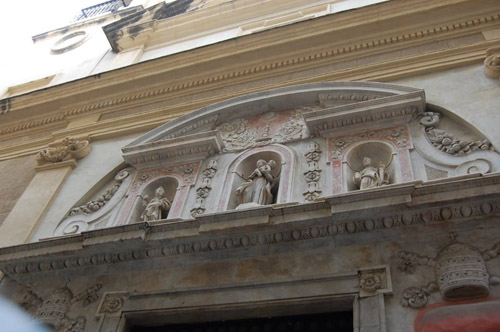 |
Return to the List of Walks in Cadiz |

Click on the button above to bring up the map for this walk. |
Walk 3 in Cadiz:
Shippers to the Indies
When we ended our Cadiz Constitution walk, we could have returned to Plaza de San Juan de Dios to begin the next one, but we noticed that the end of the Cadiz Constitution walk was quite close to the end of the Shippers to the Indies walk. So, as we did with out first walk this morning, we decided to just do this one backwards, ending back in Plaza de San Juan de Dios, where returning to the ship for a late lunch would be convenient.
When you bring up the map with the button above, you will just need to scroll a bit to the right to find Stop #15, which, since we are going backwards, will be our first stop on this walk.
Stop 15: Chapel of the Holy Cave
The Chapel of the Holy Cave was founded as a chapel for retreatants, and consists of two chapels- the Chapel of the Holy Cave and Rosario Chapel. Both are decorated with extraordinary richness and luminosity, and include the marble work of Vaccaro and Gandulfo. In the Chapel of the Holy Cave can be seen, among other outstanding works, three paintings of Goya- The Last Supper, The Loaves and Fishes and the Parable of the King's Son's Wedding. All three were restored by the Prado Museum in 2000.
This chapel was consecrated by Bishop Antonio Martínez de la Plaza en 1796, and is one of Andalusia's best examples of religious neoclassical architecture. It is the work of the architects Torcuato Cayon and Torcuato Benjumeda. The priest of the chapel, Father José Sáenz de Santamaría, enriched the church with a piece of music that accompanies the service of the seven last words of Christ. The pieces was written by Joseph Haydn, and is titled "The Seven Last Words of Our Saviour on the Cross.
Outside, the church has a beautiful late-seventeenth-century baroque façade crowned by two towers. Above, there is a large marble sculpture of the Virgen del Rosario, San Pedro (St. Peter) and San Pablo (St. Paul).
The Ministry of Culture declared the chapel to be a National Historic Monument in 1981.
Stop 14: Capilla del Rosario (Rosario Chapel)
The second chapel in this church is the Rosario Chapel, best known for its controversial sculpture.
In 1755, when the big earthquake hit Lisbon, the citizens of Cadiz marched to the sea with the statue of Our Lady of the Rosary to ward off the tsunami. In thanks for her protection, they proclaimed her patron of the city.
The Confraternity of Our Lady of the Rosary in Cadiz has honored four images since its founding in 1591. The first was a statue in the Cathedral, Lady Vulnerata, battered by English invaders in 1596 and moved in 1600 to the English College for priests in Valladolid. A replacement made in 1598 for the Dominican monastery church was burned in the Civil War. Another statue was substituted, but devotees disliked its red hair and blue eyes, so in 1943 an image by Seville sculptor Manuel José Rodríguez Fernández Andes, better resembling the earlier Madonna, replaced it.
On May 4, 1947, Pablo Cardinal Segura, Archbishop of Seville, crowned the new statue. The image goes in procession annually on October 7, during the Feast of the Rosary, and on Corpus Christi.
The church that contains this chapel was built in the sixteenth century, but the original building has undergone several renovations, being almost completely rebuilt in the early eighteenth century. At the end of the century, Torcuato Benjumeda conducted an extensive renovation, giving the ancient temple two aisles and giving it its present neoclassical appearance.
Stop 13: Plaza de Mina
From the Rosario Chapel, we walked north along
Calle Rosario
and past what appeared to be a modern
memorial to the 1812 Constitution
until we came alongside Plaza de Mina.
|
(Mouseover Image if Video Controls Not Visible) |
We didn't get a good picture of the entire plaza, but you can see my movie of it with the player at left.
Prior to 1838, the area belonged to the Convent of San Francisco, but it was donated that year to the city for a garden and plaza. Work to transform the area began under Torcuato Benjumeda, and the plaza was made 4 blocks square, with diagonals crossing in the center. The work was financed with funds collected from selling demolition materials from the former public nursing home supplemented by contributions of the residents around the square. The square was finished the following year, and statues of Generals Espoz and Mina (heroes of the War of Independence) were placed there; these are now gone. But the square was named for these generals. Over time, the name was shortened to
Plaza de Mina,
a name that has endured to the present.
One wing of the old Franciscan cloister now houses the Academy of Fine Arts. In 1897, the square was updated into the modern plaza that it is now- although the name of the square (called "Plaza del Generalísimo Franco" for a time) and the structures in the center have changed. There is now a central bandshell for music. The square is surrounded by
beautiful and stately homes,
done in a variety of architectural styles- although most are Elizabethan. Casa de Falla, a stop on our previous walk, is located nearby, and others of the houses have now become small hotels.
There are a number of
interesting tree species
in the plaza; after Genovés Park, Plaza de Mina is considered the richest concentration of tree species in the city.
Stop 12: Calle Ancha
We left Plaza de Mina walking along
Calle San Jose
to the southwest, and then turned southeast on Calle Ancha (Broad Street). This street has been the center of Cadiz commerce for over two centuries, and the name of the street is apropos as it was the widest street in the city. This pedestrian street is highly commercial, and very busy for most of the day; it is the most frequented street by Cadiz citizens.
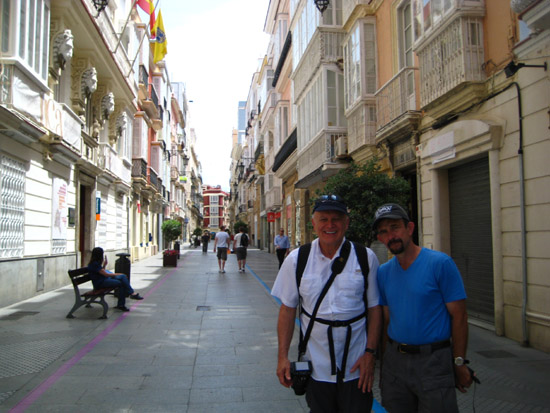
Greg and Fred on Calle Ancha
|
|
We'd crossed Calle Ancha on our previous walk, and indeed, part way down,
we crossed the blue line
of the Cadiz Constitution walk. We also passed
a bakery,
and had it not been closed for siesta we might have got a cookie or something. We took some interesting photographs along the street, and you can have a look at them with the thumbnails below:
Stop 11: Palacio de Los Marqueses de Recano
We turned south on Calle San Jose and then west on Calle Sacramento to pass in front of the Palacio de Los Marqueses de Recano.
The former palace of the Marquis of Recaño was built around 1730 in the highest part of the old town. It was done in a simple, 18th-Century baroque style, but with long vertical lines. Its signature feature is the lookout tower, which, by virtue of its being the highest in the city (and visible from everywhere) became the official Cadiz port watchtower in 1778. By this time, of course, the Marquis had moved elsewhere.
In 1787 the building became the Free School of Drawing, Arithmetic and Geometry; later, in 1857, the house became the home of the Normal School of Education. Still later, the building was acquired by the Sisters of Charity for the opening of the College of Jesus, Mary and Joseph. In 1812, the house was used as the meeting place for the new Supreme Court, before its move to Madrid a year later.
Zigzagging through the streets towards the Hospital de Mujeres was very interesting. We passed some very interesting
display windows
and took a few other good pictures of these streets. Use the thumbnails below to have a look at them:
Stop 10: Hospital de Mujeres
After jogging through a few side streets, we came to the Hospital de Mujeres.
The Hospital de Mujeres is an 18th-century women's hospital whose chapel is one of the most profusely decorated churches from Cadiz's golden century. It contains El Greco's Extasis de San Francisco (Ecstasy of St. Francis).
The Women's Hospital Cadiz stands in the center of the historic center of the city towards the middle of the eighteenth century and is one of the most emblematic buildings of the local architecture. The style of the building is clearly Baroque, designed by the Sevillian architect Pedro Luis Afanador between 1736 and 1749. He used as a model other Baroque buildings in Andalusia and adapted them to specific characteristics of Cadiz- small spaces and the use of American wood and Italian marble.
It is located on the street of the same name, where we turned to head again southeast. The building has a double courtyard, just one of the features that made the building a model for the use of light and fresh air.
We continued southeast to arrive at Plaza de Flores.
Stop 9: Plaza de Las Flores
The Square of Flowers and Doves is one of the prime commercial plazas of Cadiz; it is centrally-located, and a number of streets pass through it. On days when all the shops are open, it can be crowded all day long.
Sadly, today was not one of those days, so we had the plaza almost to ourselves. At the northeast end of the plaza is the
main post office,
and the use of this building adds more people to the plaza on weekdays. From this plaza, four or five streets lead to many other main areas of Cadiz- including Cathedral Square. The square is named because there are many stalls or small stores selling plants, cards and of course, flowers. Around the square there are some
typical shops
and restaurants.
|
(Mouseover Image if Video Controls Not Visible) |
I made a movie here in Plaza de Flores, and you can watch it with the player below, right.
Below are clickable thumbnails for some of the other pictures we took here in the Plaza of Flowers:
Stop 8: Iglesia Santiago
From Plaza de Flores, the next four stops along this particular walk were stops we'd made before on the two previous walks. The first was at the Iglesia Santiago, adjacent to the Cathedral.
In the 19th century Plaza Santiago was considered to be Cadiz’s main square. It is a beautiful square, surrounded by a number of mansions built in neo-classical architecture or Isabelline Gothic style, once occupied by the Cadiz upper classes. San Antonio church (Iglesia de Santiago),
originally built in 1669, is also situated in the plaza.
The plaza was built in the 18th century, and on 19 March 1812 the Spanish Constitution of 1812 was proclaimed here, leading to the plaza to be named Plaza de la Constitución, and then later Plaza San Antonio, after the hermit San Antonio. In an area of the plaza to the left of the entrance to the Cathedral and in front of the Cadiz town hall is the statue of a Dominican Friar- a memorial to the order. In 1954 the city's mayor proclaimed the location a historic site. All construction is prohibited.
Stop 7: Catedral Nueva
Coming around the Iglesia Santiago,
we entered Cathedral Square
and found ourselves once again in front of the Cadiz Cathedral.
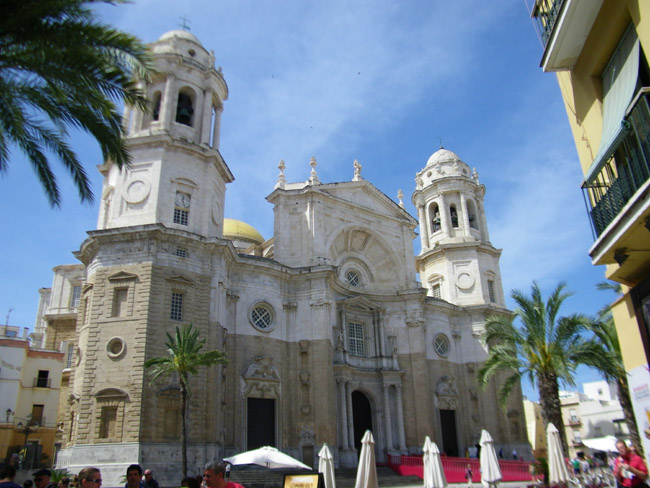
The Cathedral of Cadiz
|
|
Cádiz Cathedral (in Spanish: Catedral de Cádiz or Catedral de Santa Cruz de Cádiz) was built between 1722 and 1838. It was declared Bien de Interés Cultural in 1931. The church sits on the site of an older cathedral, completed in 1260, which burned down in 1596. The reconstruction, which was not started until 1776, required a period of 116 years to be finally completed, and was under the supervision of a number of different architects and builders. Its final style was neoclassic, and its chapels have many paintings and relics from the old cathedral and monasteries from throughout Spain.
On our first walk this morning, we spent quite some time here, inside the cathedral, in the crypts below it, and in the West Tower above it. If you have not already seen those pictures, you should definitely take the Medieval District and City Walls walk with us.
Stop 6: Casa del Almirante (The Admiral's House)
Built by Admiral Diego de Barrios at the end of the 17th century, this house is a fine example of a Baroque palace.
In the grand facade stands a cover of red and white marble, with two bodies: the lower four paired Tuscan columns and top with a balcony framed by columns and curved pediment with the family crest- these embellishments typical of the style. In the top two pilasters topped with watchtowers are set. The inside is also noteworthy, with a main hall of irregular shape with the family crest painted on the roof and yard, pointed arches on Tuscan columns, a dome and an elliptical staircase.
In 2008 work began to convert the building into a luxury boutique hotel, and you can see evidence that work is ongoing still in the picture at left. The inside, apparently, has lots of interesting features, but since we were not able to go in and have a look at them, describing them is immaterial.
Stop 5: Plaza de San Juan de Dios
On this walk, the next stop was Plaza de San Juan de Dios.
(Mouseover Image if Video Controls Not Visible)
Following the Purple Line |
From the Admiral's House, we followed
the purple line
(there were quite a few turns here, and you might be amused to use the player at right to watch my movie of our progress), which brought us into Plaza de San Juan de Dios via
Hospital de San Juan de Dios.
This one went by the old
Hospital de San Juan de Dios.
This hospital is the oldest in the city and since 1614 has been under the charge of the order of San Juan de Dios. The present building was built between 1678 and 1688. Its chapel conserves an important set of altarpieces and sculptures with one of its highlights being the plinth covered by Dutch tiles. Of course, the building is no longer used as a hospital; the nearest modern one being just outside the gate at Constitution Plaza.
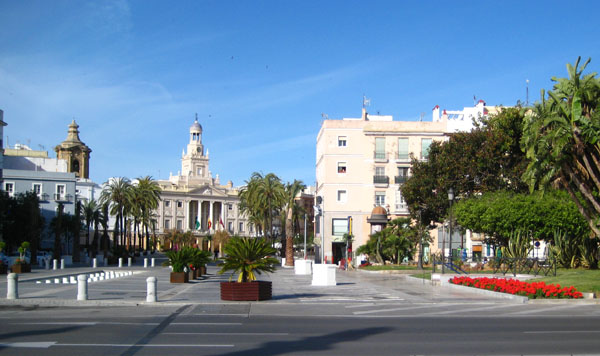
Plaza San Juan di Dios
|
|
Plaza de San Juan de Dios is another place we have been to before today; we passed by it early this morning on our way to the train station, and we went through it at the end of our Medieval District walk.
Construction of this plaza began in the 15th century on lands reclaimed from the sea. With the demolition of the City walls in 1906 the plaza increased in size and a statue of the Cadiz politician Segismundo Moret was unveiled. Overlooking the plaza,
the Ayuntamiento
is the town hall of Cadiz's Old City. The plaza is adorned in part by large planters full of
beautiful bougainvillea.
Stop 4: Casa Sopranis
From Plaza de San Juan de Dios, we continued eastward, rather than heading north to the harbor. We were just following the purple line, and it took us down
Calle Sopranis.
Down towards the end of the street, we came to an old Baroque building built in 1670. It was originally a private residence, with a front overhang featuring two marble pilasters, moldings and a niche.
In 1863 the house was renovated by Master Carlos Requejo; he respected the original structure, but added a floor and a tower.
Stop 3: Casa de Los Lilas
Basically just across the street was another former mansion now converted into an apartment building. Popularly known as "Lilacs House," it has a baroque facade with overlapping columns.
Stop 2: Convento Santo Domingo
Continuing to follow the purple line, we made a few more turns and then came out near the harbor by the church of Santo Domingo.
The convent of Nuestra Señora del Rosario and Santo Domingo (usually just "Santo Domingo Church") is located at the endge of the old city, near the port. Historically, it was the religious building Cadiz-American Dominicans used as their organizational home as they came and went across the Atlantic. The style of the building is Late Mannerist, with elements of Baroque. The church has a cloistered courtyard, three floors and two chapels.
Architecturally, this building is important as one of the Baroque buildings, done in marble, by Genoese builders, and it is evidence of the extensive trade and artistic cooperation established between Cadiz and Genoa in the seventeenth and eighteenth centuries. The church was founded in 1635 when the Order purchased several houses and lots at the spot where Anglo-Dutch attackers had thrown the image of the Virgen del Rosario in 1596. Special permission had to be obtained from the Duke of Medina Sidonia to build the church, due to its proximity to the defense works and walls. This was obtained in 1645 and construction began with the foundation. The actual church did not begin to rise until 1652; it was completed in 1666.
The monastery gained great prestige in the field of education, having hosted a university and a large library since 1681. In the mid- eighteenth century the church was renovated, so it included a rich decoration of plasterwork. It burned twice, in 1931 and 1936, but
Convento Santo Domingo
was restored in 1948.
The Walk Ends at the Centro de Recepcion de Turistas
From the Convento, we continued to follow the purple line back to the Tourist Center.
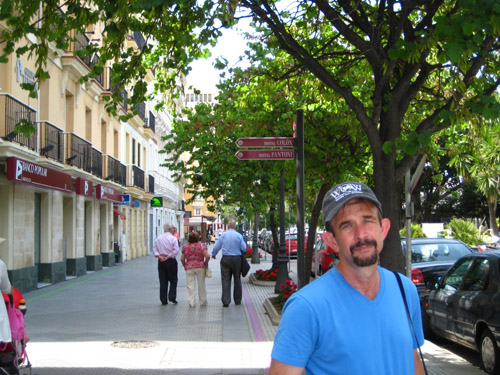
Outside the Tourist Center
|
|
At one point, we found that
the line was blocked
(temporarily) by a sidewalk cafe, but we just went around. We continued up along the harbor until
the purple line ended.
At this point, we were again at the foot of Plaza de San Juan de Dios, just outside the tourist center. Here, Fred got a picture of
a local tree in bloom
before we headed back to
the ship
for a late lunch. This brought our third walk through Cadiz to an end.
To return to the main page for our stop in Cadiz and to follow us on another of our four walks, please click
HERE
 |
Return to the List of Walks in Cadiz |



